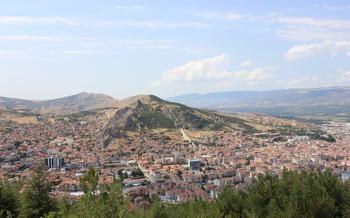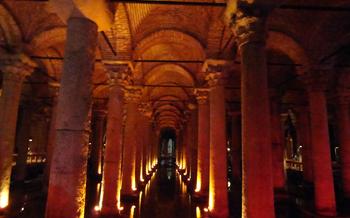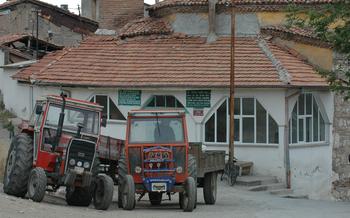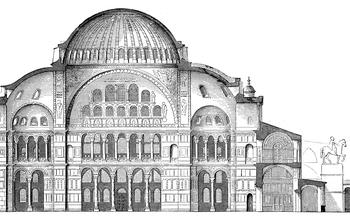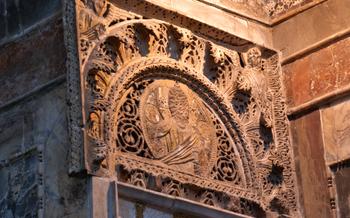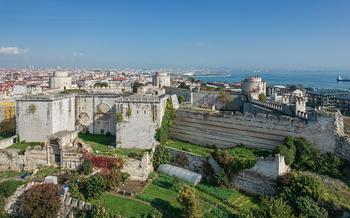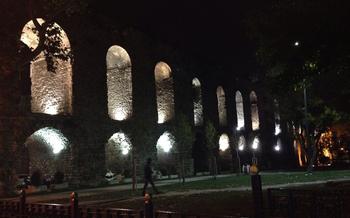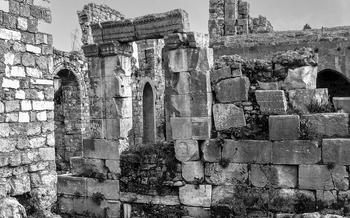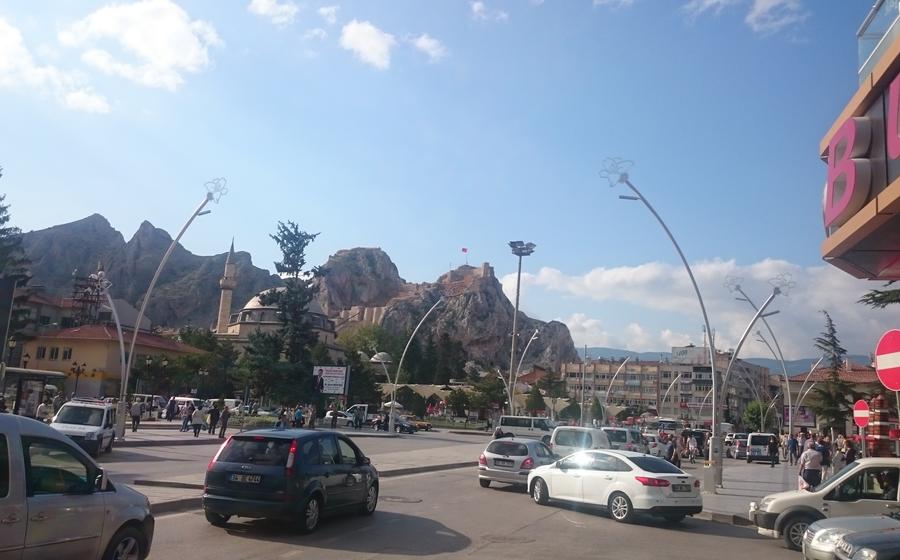
Zile Kalesi Water Cisterns
- History of the Zile Kalesi Water Cisterns:
- Location and Accessibility
- Significance of the Cisterns
- Architectural Design and Features
- Visiting the Zile Kalesi Water Cisterns
- Audio-Visual Elements
- Surrounding Attractions
- Historical Importance:
- Unique Features:
- Local Culture and Traditions
- Sustainability and Conservation Efforts
- Virtual Tours and Online Resources
- Educational Programs and Workshops
- Accessibility for Visitors with Disabilities
- Insider Tip: Unveiling the Secrets of Zile Kalesi Water Cisterns
History of the Zile Kalesi Water Cisterns:
The Zile Kalesi Water Cisterns, also known as the Zile Underground Cisterns, hold a profound historical significance in the annals of Turkey's architectural heritage. Constructed during the Byzantine era, these cisterns were an integral part of the city's water supply system, playing a pivotal role in sustaining and nurturing the burgeoning population of Zile. Their construction and subsequent modifications bear witness to the ingenuity and engineering prowess of the Byzantine Empire, demonstrating their commitment to urban planning and infrastructure development.
The cisterns' primary purpose was to store and distribute water to the city's inhabitants, ensuring a steady supply during both wet and dry seasons. Their strategic location within the city's fortifications, adjacent to the Zile Castle, further highlights their crucial role in providing a reliable water source during times of siege or conflict. Over the centuries, the cisterns have undergone several renovations and modifications, reflecting the changing needs and priorities of successive civilizations that have left their imprint on Zile's rich history.
Location and Accessibility
The Zile Kalesi Water Cisterns are situated in the heart of the Zile district, within the Tokat province of Turkey. They are easily accessible by various transportation options. The nearest major city is Tokat, located approximately 80 kilometers away. From Tokat, visitors can take a convenient bus ride or hire a car for a scenic drive to Zile. The cisterns are just a short walk from the Zile town center, making them easily reachable on foot or by local transportation.
For those arriving by air, the closest airport is Tokat Airport, which offers domestic flights from major cities in Turkey. From the airport, visitors can take a taxi or rent a car to reach Zile, which takes about an hour and a half. Guided tours are also available, providing a hassle-free and informative experience for visitors who prefer a structured itinerary. These tours typically include transportation to and from the cisterns, as well as knowledgeable guides who share insights into the history and significance of the site.
Significance of the Cisterns
The Zile Kalesi Water Cisterns hold immense historical significance as an ancient water storage system that played a crucial role in the water supply for the city of Zile. Constructed during the Byzantine era, these cisterns served as a vital source of water for the population, ensuring a continuous supply even during periods of drought or siege. The cisterns' engineering and technological advancements showcased the ingenuity and expertise of the ancient builders, demonstrating their understanding of water management and hydraulics. Their construction reflects the importance placed on securing a reliable water source for the city, emphasizing the cisterns' role in the overall infrastructure and urban planning of Zile.
Furthermore, the Zile Kalesi Water Cisterns can be compared to other historical cisterns found throughout Turkey, highlighting their unique characteristics and contributions to water management systems. For instance, the cisterns in Istanbul, such as the Basilica Cistern and the Yerebatan Cistern, are renowned for their elaborate architecture and impressive size, showcasing the grandeur of the Byzantine and Ottoman empires. In contrast, the cisterns in Zile, though smaller in scale, exhibit a more utilitarian design, prioritizing functionality and efficiency in water storage and distribution. Understanding these comparisons provides a broader perspective on the diverse approaches to water management in different regions and periods of Turkish history.
Architectural Design and Features
The Zile Kalesi Water Cisterns stand out for their unique architectural style and construction techniques. Built underground, the cisterns comprise a series of vaulted chambers and galleries supported by massive stone pillars and arches. The impressive structural design allowed the cisterns to withstand the weight of the water and the pressure exerted by the surrounding soil.
The cisterns exhibit intricate craftsmanship and attention to detail, showcasing the engineering prowess of their builders. The walls and vaults are constructed using carefully fitted stone blocks, forming a watertight seal. The use of pointed arches, a hallmark of Gothic architecture, enhances the structural integrity of the cisterns while adding a touch of elegance to their design.
The cisterns are divided into several chambers, each covered by a separate vault. This compartmentalization served a practical purpose, allowing for the efficient storage and distribution of water. The chambers are interconnected by narrow passages and staircases, adding to the cisterns' labyrinthine allure.
The cisterns also feature ventilation shafts that extend to the surface, ensuring a constant flow of fresh air and preventing the accumulation of harmful gases. These shafts are cleverly concealed within the fortress walls, blending seamlessly with the surrounding architecture.
Overall, the Zile Kalesi Water Cisterns showcase a remarkable fusion of functionality and aesthetics, demonstrating the ingenuity and expertise of their ancient builders. Their unique architectural design and impressive construction techniques continue to captivate visitors to this day.
Visiting the Zile Kalesi Water Cisterns
The Zile Kalesi Water Cisterns are open to the public daily, with varying hours depending on the season. Admission fees are minimal, offering an affordable opportunity to explore this hidden gem. Guided tours are available for a more in-depth experience, providing insights into the cisterns' history, significance, and architectural features.
For those who prefer a more independent exploration, self-guided tours are also an option. Information panels and signage are strategically placed throughout the cisterns, offering valuable information and context. To capture the best lighting and avoid large crowds, consider visiting early in the morning or during the shoulder seasons (spring and fall).
Photography and videography are permitted within the cisterns, allowing visitors to document their experience and share the beauty of this underground marvel with others. However, the use of tripods and flash photography is restricted to preserve the cisterns' delicate environment.
Audio-Visual Elements
Immersive Experiences at the Zile Kalesi Water Cisterns
Enhance your visit to the Zile Kalesi Water Cisterns with a range of audio-visual elements that bring history to life. Immerse yourself in the past through interactive exhibits, historical reenactments, and multimedia presentations.
-
Interactive Exhibits: Engage with interactive displays that provide detailed information about the cisterns' construction, purpose, and significance. Learn about the ancient engineering techniques and marvel at the ingenuity of past civilizations.
-
Historical Reenactments: Step back in time and witness live performances that recreate scenes from the cisterns' past. Costumed actors bring to life the stories of the people who built, maintained, and utilized these remarkable structures.
-
Multimedia Presentations: Immerse yourself in captivating multimedia presentations that showcase the cisterns' architectural features, historical significance, and cultural impact. Experience the cisterns from different perspectives and gain a deeper understanding of their importance.
With these audio-visual elements, the Zile Kalesi Water Cisterns offer an unforgettable journey through history, providing visitors with a truly immersive and engaging experience.
Surrounding Attractions
In addition to the cisterns themselves, there are a number of other attractions in Zile that are worth exploring. These include the Zile Castle, which dates back to the 12th century and offers stunning views of the city, and the Zile Ethnography Museum, which houses a collection of artifacts and exhibits that tell the story of the city's rich cultural heritage. For those interested in shopping, the Zile Bazaar is a great place to find a variety of souvenirs and local products. And for those who want to relax and enjoy the outdoors, the Zile Park is a beautiful green space with a variety of walking trails and picnic areas.
Historical Importance:
The Zile Kalesi Water Cisterns hold immense historical significance in the context of Turkish history. These underground reservoirs played a critical role in the development and prosperity of the city of Zile. Constructed centuries ago, the cisterns served as a reliable water source for the city's inhabitants, ensuring a steady supply during periods of drought or siege. Their strategic location within the Zile Fortress further enhanced their importance, providing a vital resource for the city's defense.
Throughout history, the cisterns have witnessed numerous events and changes. They have survived wars, natural disasters, and the passage of time, standing as a testament to the resilience and ingenuity of the people who built them. Their historical importance extends beyond their practical function, as they also serve as a reminder of the rich cultural heritage and architectural achievements of the region.
Unique Features:
The Zile Kalesi Water Cisterns stand out with several distinctive features that set them apart from other cisterns in Turkey. One notable characteristic is their impressive size and scale. With a capacity of approximately 9,000 cubic meters, they are among the largest cisterns in the region. Their grand dimensions underscore their importance as a vital water storage facility for the city of Zile.
Another unique aspect of the cisterns is their well-preserved condition. Despite their age, they have been meticulously maintained and restored over the years. As a result, visitors can still appreciate the cisterns' original architectural elements and intricate details, such as the barrel-vaulted ceilings, stone arches, and niches.
The Zile Kalesi Water Cisterns are also significant for their artistic and decorative elements. The interior walls are adorned with beautiful carvings and inscriptions, which provide valuable insights into the history and culture of the region. These decorative elements add a touch of elegance and artistry to the cisterns, making them visually captivating and aesthetically pleasing.
Finally, the cisterns are steeped in local folklore and legends. According to one tale, the cisterns were built by a giant who used them to store his water supply. Another legend tells the story of a secret tunnel that connects the cisterns to the nearby Zile Castle, allowing for the transportation of water and supplies during times of siege. These stories add an air of mystery and intrigue to the cisterns, making them even more fascinating to visitors.
Local Culture and Traditions
The Zile Kalesi Water Cisterns hold a deep cultural significance for the local community. For centuries, these cisterns have been an integral part of the city's identity and heritage. Locals regard the cisterns with a sense of pride and admiration, recognizing their importance in shaping the city's rich history.
Folklore and legends surrounding the cisterns have been passed down through generations, adding to their mystique and allure. One popular legend tells of a hidden treasure buried beneath the cisterns, guarded by ancient spirits. Locals have a deep respect for the cisterns, viewing them as a symbol of resilience and perseverance.
Traditional ceremonies and rituals associated with the cisterns reflect the deep connection between the local community and this historical landmark. During the annual Zile Water Festival, the cisterns become the centerpiece of celebrations, with locals gathering to pay homage to their cultural heritage. These festivals showcase traditional music, dance, and storytelling, all centered around the significance of the cisterns.
The cisterns have also inspired local artisans and craftsmen, who create intricate handicrafts and souvenirs depicting the cisterns' unique features. These handmade items are a testament to the local community's pride and appreciation for their cultural heritage.
Sustainability and Conservation Efforts
The Zile Kalesi Water Cisterns have withstood the test of time, but their preservation requires ongoing efforts. Local authorities and heritage organizations collaborate to ensure the cisterns' longevity. Regular maintenance and repairs address structural issues, while restoration projects aim to retain their original features. These initiatives involve skilled artisans and experts specializing in historical preservation.
One of the challenges lies in balancing conservation with accessibility. While efforts are made to preserve the cisterns' authenticity, they are also adapted to accommodate visitors. This includes implementing safety measures, creating accessible pathways, and installing lighting systems that minimize damage to the structures.
Sustainability is a key consideration in the cisterns' management. Rainwater harvesting systems and vegetation are used to maintain the surrounding environment. By protecting the cisterns and their surroundings, authorities aim to ensure that future generations can appreciate this remarkable heritage site.
Virtual Tours and Online Resources
For those unable to visit the Zile Kalesi Water Cisterns in person, several virtual tours and online resources offer a glimpse into their history and significance. The official website of the Turkish Ministry of Culture and Tourism provides a comprehensive overview of the cisterns, including detailed descriptions, historical information, and high-quality images. Additionally, various travel blogs and websites feature articles and photo galleries dedicated to the cisterns, offering personal perspectives and insights. These online resources allow enthusiasts to explore the cisterns from afar, learn about their unique features, and appreciate their historical and cultural importance.
Educational Programs and Workshops
The Zile Kalesi Water Cisterns offer a range of educational programs and workshops designed to engage visitors of all ages. School groups and families can participate in hands-on activities and interactive learning experiences that delve into the history, architecture, and significance of the cisterns. These programs provide a unique opportunity to learn about ancient water management systems, engineering advancements, and the cultural heritage of the region.
Workshops and seminars are also organized for the general public, covering topics such as water conservation, sustainability, and the preservation of historical sites. Visitors can gain insights into the challenges faced in maintaining and restoring ancient structures, as well as the importance of protecting our water resources. These educational initiatives aim to foster a deeper understanding and appreciation for the Zile Kalesi Water Cisterns and their enduring legacy.
Accessibility for Visitors with Disabilities
The Zile Kalesi Water Cisterns strive to ensure an inclusive and accessible experience for all visitors, regardless of their physical abilities. Wheelchair users and visitors with limited mobility can easily navigate the cisterns' interior through designated ramps and accessible pathways. Braille signage and audio guides are also available to assist visually impaired visitors in exploring the cisterns independently. Additionally, reserved parking spaces and accessible restrooms are provided for the convenience of visitors with disabilities. With these thoughtful accessibility features in place, everyone can enjoy and appreciate the historical significance and architectural beauty of the Zile Kalesi Water Cisterns.
Insider Tip: Unveiling the Secrets of Zile Kalesi Water Cisterns
For an unforgettable experience, venture beyond the main cistern to discover hidden chambers and secluded corners that reveal the cisterns' intriguing past. Seek out the secret staircase that leads to a hidden viewing platform, offering a breathtaking panoramic vista of the entire complex. Capture unique photographs from this elevated vantage point, showcasing the cisterns' grandeur and intricate architectural details. Don't miss the opportunity to explore the surrounding area, where you'll find charming local shops and restaurants serving traditional Turkish cuisine. Engage with the friendly locals, who are always eager to share stories and insights about the cisterns and Zile's rich history. Embrace the local culture by visiting the nearby markets, where you can find authentic handicrafts, souvenirs, and fresh produce.
